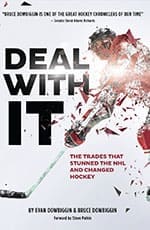The following is an excerpt from Deal With It – The Trades That Shook Hockey and How They Changed The Game by Evan and Bruce Dowbiggin
There’s one abiding truth in hockey. Whichever team gets the best player in a deal wins the trade.
After that, the received wisdom on trades is more honoured in the breach than in the observance.
Everyone has a theory. Trade before their value depreciates. Get everything you can for your money before trading. Sit tight and let the market come to you. But all agree on the impact of trades toward success in the century-plus of NHL competition. From their evolution as simple player-for-player deals in the NHL’s Paleozoic era to the current version of trading players for draft picks, cash, future considerations, salary-cap space, salary retention or actual humans, the art of swapping in the NHL has become a science, an art and an accounting trick. And, often, an exercise in blind luck.
 Bruce Dowbiggin |
 Evan Dowbiggin |
Trading has quirks. Just ask Alan May, who played from 1988 to 1995. He holds the distinction for the most times a player has been traded on deadline day. May was traded a total of five times in his career, with four of the deals happening at the NHL late-season deadline (1988, 1989, 1994, 1995). The teams that acquired him were Edmonton, Los Angeles, Dallas and Calgary. None won a Cup as a result. (But at least Alan got air miles.)
Speaking of the annual trade mart, it’s considered gospel that Cup contenders use it to upgrade their chances. In the salary-cap era, the eventual champions have always made a deal within two weeks of the deadline. In 2011, the future champ Bruins made five deals within two weeks of the deadline, acquiring Chris Kelly, Tomas Kaberle, Rich Peverley, Boris Valabik, Anton Khudobin, Stefan Chaput and David Laliberte. None played a major role in Boston’s win over Vancouver.
The fewest moves made in a deadline season by the eventual Stanley Cup champions in the salary-cap era? One. Three different teams. In 2006, Carolina acquired Mark Recchi on deadline day; in 2008, Detroit picked up Brad Stuart on deadline day; and in 2012, Los Angeles acquired Jeff Carter four days before the deadline. Those single trades were largely instrumental in their success. Go figure.
In the early days of the NHL, deals were gentlemen’s agreements written on the margins of a program and then phoned into the Montreal head office, which kept banker’s hours for decades. This worked both ways. The famous 1962 Frank Mahovlich non-trade from Toronto to Chicago was sealed by a personal cheque from Hawks owner Jim Norris to Leafs co-owner Harold Ballard in a bar. A delay in filing the weekend deal with the league allowed Toronto’s other co-owner, Stafford Smythe, enough time to have it cancelled. Toronto finally traded “The Big M” in 1968.
Even the advent of the fax machine did not push the reporting of trades into a 24/7 business. There are legendary stories of deals made and not made because of fax machine delays. Finally, the vagaries of the 21st-century trade deadline caught up to the NHL, allowing clubs to register deals outside regular office hours in New York City and the NHL Central Registry in Montreal. Also, email and phone calls have largely replaced the fax machine as the modes to report trades.
On trade deadline day, the final tally of trades depends on the league’s ability to receive and process the volume of deals in about 10 hours. This process often takes a couple of extra hours past the deadline itself.
It’s also more than logistics. Where once a pair of hockey-lifer GMs made deals, today’s moves require apologists (experts in managing the salary cap of a sports team), accountants, lawyers, agents and, often, the player’s family being onside before a deal can be approved by the NHL. A whole new culture has grown up within the sport so that deals can be swung.
As trades have become more complicated, they have concurrently become easier to complete. The idea of two GMs cooking up a trade in the stands at a game or in a restaurant is outdated. As one anonymous GM told Sportsnet, “Everything is done by phone. It’s a cold call. It’s the toughest part of the whole deal. It’s always initiated by the buyer, and when you’re making the call, just by making it, you’re telling another GM, ‘I don’t think your team is going to make the playoffs.”
Some deals were large – 32-year-old Rangers captain Andy Bathgate going to the defending Stanley Cup champion Maple Leafs in 1964 with forward Don McKenney for wingers Dick Duff, Bob Nevin and Billy Collins as well as young defencemen Arnie Brown and Rod Seiling on February 22, 1964. Typical of the callous style of the times, the two clubs were scheduled to meet that very night in Toronto.
Seiling learned his fate from the radio, not from the Leafs. Nevin was called by Leafs executive King Clancy, who told him to report to Maple Leaf Gardens but to go to the visitors’ dressing room. “We just traded you,” King told a disconsolate Nevin, who went on to become the Rangers captain himself. Nevin never forgot the cold departure from an organization he’d played in since boyhood.
As for Bathgate, who lasted just two seasons in Toronto, the former captain of the Rangers claimed he was dealt for being impertinent in insisting New York hang on to future Hall Of Fame centre Jean Ratelle. “Muzz Patrick told me right then and there, ‘you’re getting too big for your britches’. Right after that I was history. I was traded because I spoke up for a guy who they didn’t think was tough enough.” (That team assessment proved foolish in the long run, as the late-blooming Ratelle followed many years of inconsistency and injury to become a superstar in his 30s).
Other deals took a while to produce results. In 1964, for instance, Montreal’s wily GM Sam Pollock snapped up a 16-year-old goalie who was buried in the Boston system. After a diversion to Cornell University that pushed his NHL arrival off to a too-distant future for an impatient Bruins organization, Ken Dryden would eventually go on to win six Cups as the Canadiens No.1 goalie. Neither of the players in the Bruins’ haul, Paul Reid and Guy Allen, ever played in a single NHL game.
Bruce Dowbiggin is the editor of Not The Public Broadcaster. Evan Dowbiggin is a sports statistical researcher who runs TSN’s Twitter stats page and has been a part of Sportscentre’s behind-the-scenes team for over a decade.
For interview requests, click here.
The opinions expressed by our columnists and contributors are theirs alone and do not inherently or expressly reflect the views of our publication.
© Troy Media
Troy Media is an editorial content provider to media outlets and its own hosted community news outlets across Canada.


